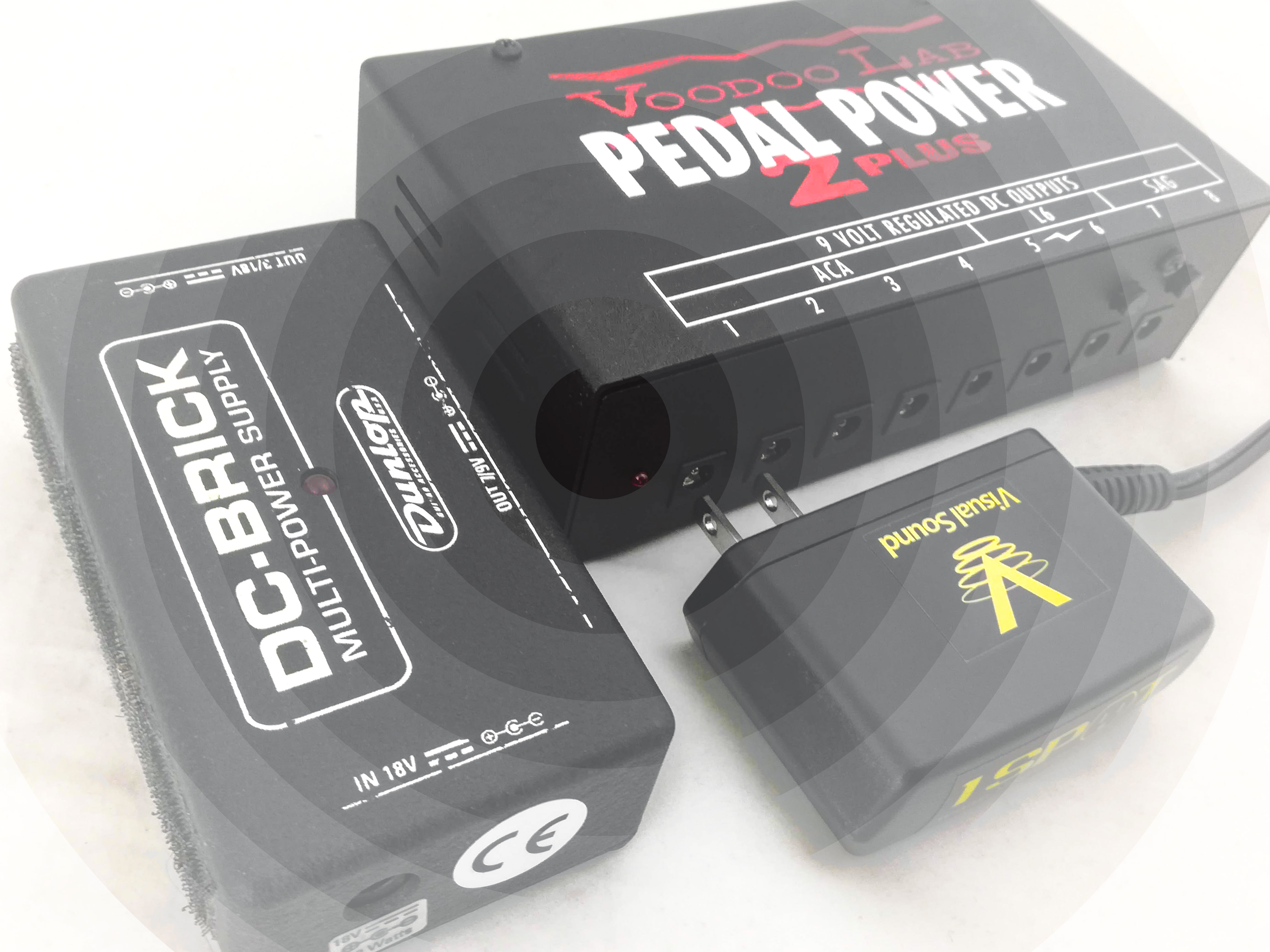Guitar is a naturally noisy instrument. Throw 50 decibels of gain at it, crank your amp, and it’s safe to say there will be some noise.
It’s amazing that any guitar rig isn’t a noise nightmare. Our copper wound guitar pickups make great antennas, and if you are anywhere near electricity 60 cycle hum is being broadcast all around you.
We regularly get calls and emails about 60 cycle hum issues. Sometimes the source is a bad cable, faulty pedal, or standing under 1000 watts of fluorescent lighting. More often than not it’s the power supply.
Low quality power supplies cause problems that noise suppressors, expensive cables or even power conditioners can’t fix. It’s surprising after someone describes an elaborate pedalboard, then mentions running it all on a $6.99 power supply they found on ebay.
Even more troubling, many of these unscrupulous sellers list brand names in their auction’s titles making them seem like an “official” accessory. Our brand name get’s used this way often. None of these sellers have taken the time to contact us and make sure any of these power supplies actually work with our pedals.
So what’s going on? Where is all this noise coming from?
All DC power supplies take the AC voltage from the wall and turn it into the direct current we use to power our stompboxes. In its simplest form a power supply is little more than a transformer and a rectifier circuit. Unfortunately this leaves far too much AC ripple in the “DC” power which overwhelms just about any pedal with 60 cycle hum.
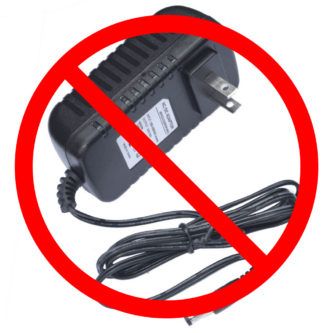
Just say no. It’s not really a bargain if it doesn’t work with your gear.
Perhaps you’ve seen some power supplies labeled as “regulated.” Regulated power supplies add a voltage regulator and some hefty filtering capacitors, but some are better regulated than others. If they were designed for routers, cordless phones or battery chargers maybe a small AC ripple won’t matter.
For most guitar effects removing the AC ripple is essential. The power supply needs to maintain a steady voltage output and deliver enough current to power everything it’s plugged into. (Most pedals have current requirements marked in milliamps on the back or in the manual.)
Designing a compact power supply that delivers a ton of current is easy if you don’t mind some AC ripple. Regulated power supply designs are straightforward as well, but they deliver less current, require a few extra parts and some hefty filtering capacitors. Designing a power supply that does both is more challenging and not something you’ll find for $6.99.
Overloading the power supply can be a source of noise, but this is rarely the problem. Inexpensive imported power supplies are often rated for 2000 milliamps or more. Even power thirsty pedals rarely require more than 100 milliamps.
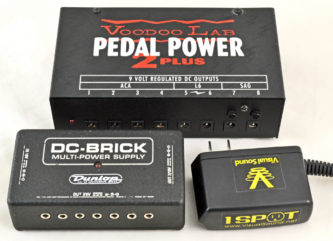
Some of our favorite power supplies
*Power Supply Solutions!
All power supplies have weaknesses. Nothing is perfect, but investing in a quality power supply for even a modest pedalboard can reduce hours of troubleshooting later on. It’s really helpful if the power supply is made by a company that is known in the effects world.
Our first recommendation is usually the Truetone (formerly Visual Sound) 1 Spot. For under $30 you get the power supply, a daisy chain cable for powering multiple pedals and a host of adapters for any oddball connectors you might need for older pedals.
The 1spot delivers more current than most pedalboards could ever use.
There are still a few shortcomings and potential problems. Your pedals will share a ground connection through the power supply. It can only power 9 volt pedals. That daisy chain cable can be a real mess to rout around any pedalboard. But usually you plug it in and it works. It’s infinitely better than generic power supplies found on ebay and amazon.
For $30 it is a good place to start. If it doesn’t work perfectly it’s affordable enough to keep as a back up or power another board to keep at home or at your rehearsal space.
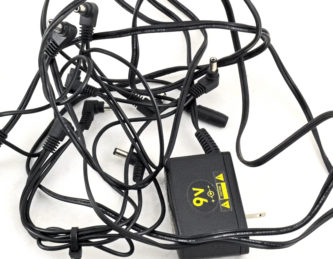
It might not be pretty, but it usually works.
Highly Recommended
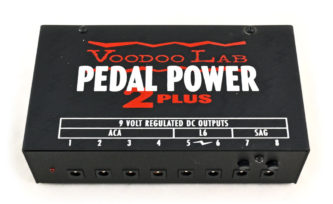
Voodoo Lab Pedal Power 2 Plus.
Our second recommendation, and our go to power supplies at Subdecay, are from Voodoo Lab. There are several options for distributing power to your board, including the number of outputs, current ratings and voltages. It’s a good idea to do some homework before buying and make sure you choose the power supply that meets your needs. The power outputs are electrically isolated (we’ll cover isolation in another post) with super clean power, and designed with powering pedalboards in mind.
The Dunlop DC brick was around for a long time. They’ve been discontinued, but you can sometimes still find them on clearance at stores. You can probably pick one up on craigslist for under $50.
While it does appear to have the same advantages as the voodoo lab power supplies, it shares a shortcoming with the 1spot. The “brick” is really just a glorified breakout box in place of a daisy chain. The breakout box form factor makes it easier to keep a large pedalboard organized.
It’s also a worthwhile option if you have pedals that require 18 volts. That’s something the the 1spot can’t do.
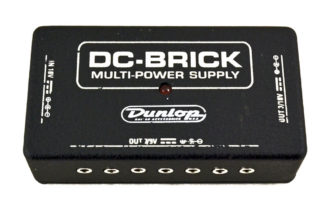
An old-school solution with versatility.
More options…
These are a few we’ve heard great things about from our customers. We haven’t tried them all our selves, but if you do your homework you might find something that meets your pedal’s power supply needs.
- Truetone 1spot pro: Isolated multitap power supplies from the makers of the 1spot.
- Cioks power supplies: Lots of options including power supplies with up to 16 outputs.
- T.Rex fuel tanks: We’ve never used one of these, but we hear great things. The Fuel Tank Junior is one of the most affordable multi-tap power supplies with isolated outputs.
25 years ago when I started playing guitar there weren’t many choices. Usually it was a power strip with a multitude of wall warts running long cables to all your pedals. Thankfully those days are over. It’s 2017 and we don’t have to power our pedals like barbarians anymore.
